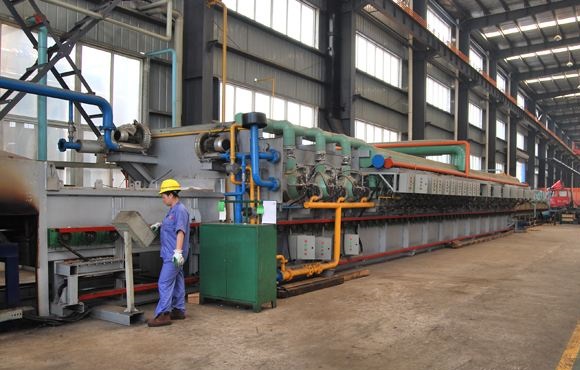Categories
- Pipe & Tube (18)
- Flange & Fitting (97)
- Fastener & Gasket (12)
- Valve & Pump (18)
- Base Material (11)
- Equipment (8)
- Application (30)
- Technical (110)
Austenitic stainless steels are widely used in diverse civil, industrial and military applications. They may be provided in many product forms such as bar, rod, plate, sheet, strip, foil, pipe, tube, fitting, flange, and other forgings. A final solution annealing treatment followed by a quench shall be done to make sure that all carbides are fully dissolved in the austenite and there is no intergranular precipitation of carbides. If the heat treatment is done in a common furnace, chromium content of the austenitic stainless steel will react to the oxygen of the air and form a grayish layer of oxide, which is called “scale”. The scale, which is a depletion of the austenitic stainless steel, shall be removed by a pickling process.

The bright annealing furnace for stainless steel tubing in a pipe mill, located in Huzhou, Zhejiang Province, China.
In order to maintain the good appearance (original metal luster) and exempt it from pickling, the austenitic stainless steel shall be solution annealed in a protective or vacuum atmosphere to prevent discoloration of the bright surface. This process is known as “bright annealing”. All grades of austenitic stainless steel can be bright annealed. The protective atmosphere may be pure hydrogen, dissociated ammonia, or sometimes vacuum. The protective atmosphere prevent surface oxidation of the austenitic stainless steel product during the solution annealing and quenching process. Bright annealing not only relieves work hardening of the austenitic stainless steel improving its ductility, but also enhance the corrosion resistance by eliminating intergranular carbide precipitation with aesthetic surface appearance.
The protective atmosphere shall be prepared or produced first by cracking ammonia: liquid ammonia is heated to gas, which is subsequently delivered to the cracking vessel, where the gasified ammonia is completely dissociated into nitrogen (N2) and Hydrogen (H2) under catalysts and continued heating. Care must be taken since the presence of any undissociated ammonia will result in objectionable intriding action. Because the undissociated gas is entirely soluble in water, its removal can be easily accomplished. However, the remaining fully dissociated product must be processed through drying towers to restore the required low dew point. The lower dew point is extremely critical since it means there is less detrimental moisture/water in the protective atmosphere. Usually, the dew point of the atmosphere shall be less than -60°F [-50°C]. The final protective atmosphere consists of 3 parts of H2 and 1 part of N2.
The furnaces used in bright annealing must be clean, moisture free, and tight. The austenitic stainless steel products, upon entering the furnace, shall be dry and scrupulously clean. In the protective atmosphere, the austenitic stainless steel products are heated to a temperature higher than its austenitizing temperature and are held for a time long enough to dissolve all chromium carbides. Take stainless steel 304 for example, the austenitizing temperature is usually controlled at 1070°C±20°C. Then the work shall be rapidly cooled in the same atmosphere to avoid carbide precipitation at grain boundaries. To maintain close control of dew point, atmosphere samples should be withdrawn from the furnace at frequent intervals and tested or continuously monitored.
